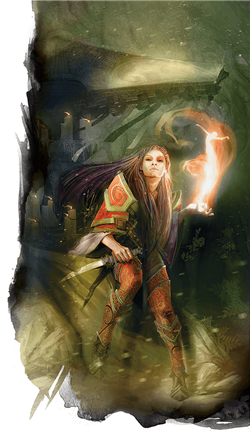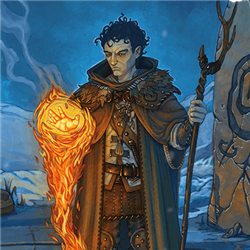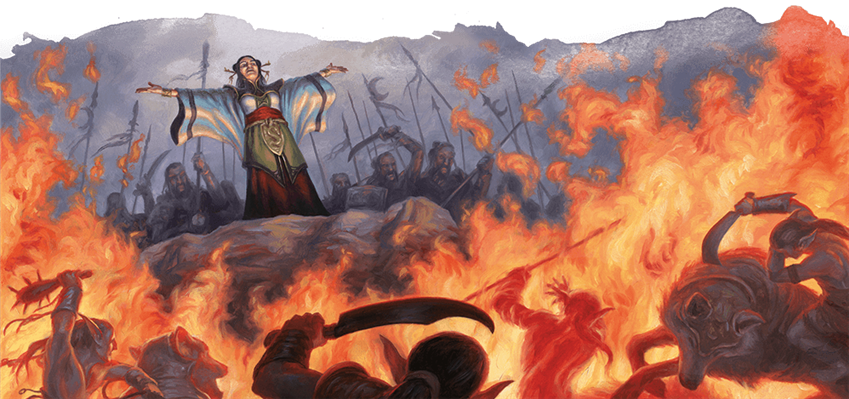Spell Spotlight: Fireball
Spell Spotlight is a series that focuses on excellent, problematic, underappreciated, overrated, or just plain weird spells in Dungeons & Dragons. Fireball is one of Dungeons & Dragons’ most iconic and satisfying spells, especially for players. While it can be fun to nitpick problematic spells to shreds, it’s just as worthwhile to take apart the game’s most iconic spells in order to understand why they’re so fun… and to give you tips on how to use them to greatest effect in your home game, both as a player and as a Dungeon Master!
What Does Fireball Do?
 Fireball is a spell that almost every D&D players knows about. It allows arcane spellcasters to deal massive damage in a wide area from long range, making it a powerful option in almost every combat situation.
Fireball is a spell that almost every D&D players knows about. It allows arcane spellcasters to deal massive damage in a wide area from long range, making it a powerful option in almost every combat situation.
Fireball’s Strengths
This spell has a range of 150 feet, meaning that as long as you have line of sight to your target, you will almost always be able to hurl a fireball at it. Since fireball begins as a streak of light and then explodes upon reaching its destination, you can shoot a fireball through a tiny opening like a keyhole, allowing you to stay behind cover while hurling fiery doom at your enemies.
Fireball deals unusually high damage for its spell level, hitting all targets within a 20-foot radius for 8d6 fire damage (an average of 28 damage per creature). The Dungeon Master’s Guide suggests that 3rd-level spells that deal damage to multiple creatures should deal 6d6 damage per creature. We’ll come back to this later. Simply put, if you just want to deal damage to a lot of creatures at once, there’s no better spell than fireball.
Fireball's Weaknesses
Unfortunately for players, fireball deals exclusively fire damage, which is the one of the most commonly resisted damage type in Dungeons & Dragons. In the Monster Manual alone, 37 creatures are resistant to fire damage and a whopping 40 creatures are immune to fire damage! Only cold has more resistances (not counting damage from nonmagical weapons), and only poison has more immunities. Keep in mind also that creatures which are fully submerged in water are resistant to fire damage.
Fireball also doesn’t distinguish friend from foe. Unless you're an evocation wizard with the Sculpt Spells feature, it’s possible that shooting a fireball into melee will also scorch some of your allies within an inch of their lives.
Finally, fireball has almost no utility outside of combat. It’s big, flashy, and noticeable, making it useless in stealth situations, and its only use is to deal massive amounts of damage.
For Players: Making the Most out of Fireball
 Throwing a fireball into a crowded dungeon room feels great, but it sucks to look on as the smoke clears and see that not even a single creature went down because of your spell. Or worse, to find that only your allies were knocked out by the spell, putting your side in a worse position than they were in before. Fireball is a simple spell on the surface, but it still takes skill to make the most out of your spell.
Throwing a fireball into a crowded dungeon room feels great, but it sucks to look on as the smoke clears and see that not even a single creature went down because of your spell. Or worse, to find that only your allies were knocked out by the spell, putting your side in a worse position than they were in before. Fireball is a simple spell on the surface, but it still takes skill to make the most out of your spell.
Make use of that range. Fireball’s 150-foot range is one of its most overlooked strengths. Generally, though, it means that you can always use this spell, no matter where you are on the battlefield. The only exception is in the rare long-distance encounter on the open plains or in vast Underdark caves—and even then, you're still able to blast the enemy before they enter shortbow range. Paired with fly, spider climb, or other movement-enhancing spells, you can bombard the enemy from all sorts of clever positions.
Aim off-center. One of fireball’s greatest strengths is also one of its greatest drawbacks: its area of effect. If you can't Sculpt Spells, you need to be careful in order to avoid scorching allies, burning important bridges (or load-bearing wooden beams... that's a bad one), melting golden treasure, or otherwise causing collateral damage. Fortunately, fireball specifies that you can choose any point within range to center the explosion on, including a point in midair or in the corner of the room. There aren’t any bonuses to catching the enemy in the middle of the explosion, so choose the most convenient spot to center your blast!
Tear up that asbestos. Like we learned earlier, fire is one of the most commonly resisted and negated damage types in fifth edition D&D. You do not want to fireball a room just to learn that everything in there took half (or worse, zero) damage from your big spell. If fireball is your only big offensive option, then you need to learn the Elemental Adept feat, which not only lets your spells ignore resistance to an elemental damage type of your choice, but also lets you change rolled 1s to 2s from those spells, pairing perfectly with spells like fireball that roll fistfuls of dice.
An earlier version of this article erroneously said that the Elemental Adept feat allows you to reroll results of 1 and 2 on those spells, similar to the Great Weapon Fighting fighting style. If you houserule your game, I would suggest modifying the Elemental Adept feat to work this way. While it's a not-insignificant increase in power, Elemental Adept is so specialized a feat that it could use a bit more oomph to make it shine.
(Of course, the other way to avoid this problem is to prepare spells that deal a wide range of damage types and not specialize too much, but where’s the fun in that?)
Work with your Dungeon Master. There's one player request that I get in almost every campaign I've ever run: "Can I change my fireball to use a different element?" I’ve seen an “acid bomb” spell that deals acid damage instead of fire, and a “lightning burst” that deals lightning damage. And I almost always say yes. I urge players and Dungeon Masters to work together to create spells that better fit the players’ character concepts.
I do have a few exceptions to this damage reflavoring, though. As said earlier, fire is an easily countered damage type. Most of the elemental types (acid, cold, fire, lightning, and thunder) are very commonly resisted, as is poison, so it’s fine to modify fireball to use these damage types. However, force, necrotic, psychic, and radiant damage are all dangerous options because very few creatures are resistant to them. If you want to turn your fireball into a “solar flare” spell, you should lower the spell’s damage from 8d6 fire damage to 6d6 radiant damage as a tradeoff for getting a superior damage type.
For Dungeon Masters: Understanding Fireball’s Nuanced Design
Fireball is a strange egg from a game design standpoint. Compared to other 3rd-level spells, fireball deals an absolutely ridiculous amount of damage; according to the Dungeon Master's Guide's spell creation guidelines, it ought to be a 5th-level spell. Lightning bolt is a comparable spell that deals this same inflated damage, but it has a clear drawback compared to fireball—it requires much more precise positioning in order to use effectively.
Mysteries of Game Design

If fireball is so overpowered by the numbers, how did it get past playtesting? Let’s approach this from a game design perspective: why would a spell deal so much more damage than other spells of its level? There are a few possible balancing factors. It deals fire damage, which is commonly resisted and even more commonly negated. It has the possibility of damaging your own allies. It’s a particularly unsubtle spell, making stealth all but impossible. And also, the spell only deals damage; it has no other side effects that might inconvenience the enemy like knocking them prone, poisoning them, or stunning them.
Those are all factors that a game designer should consider when creating a spell (especially a single-purpose spell like fireball), but none of them are the real reason. D&D's designers have actually revealed to us the reason for fireball's ridiculous damage, and it has everything to do with the culture and narrative of D&D, not its mathematical balance. Fireball is one of D&D’s most iconic spells. The sheer power of fireball is central in many fun D&D stories, as reported by playtest information from the playtests that gave form to fifth edition D&D. The designers saw fireball (and to a lesser extent lightning bolt) as integral to the experience of playing a wizard in D&D, and chose to improve its destructive power to encourage players to learn that spell over other less iconic ones.
Unbalanced on Purpose
Fireball is a carrot urging players to to play D&D in a certain archetypal way. And if that makes it unbalanced, so be it. Faced with this knowledge, DMs like me who relish in tinkering with the game have a few choices.
Fight Back
If you’re a Dungeon Master interested in strict balance for your home D&D game, you could consider toning down the power level of fireball to the Dungeon Master’s Guides’ suggestion of 6d6 damage. It’s a nerf that could ultimately help other 3rd-level spells shine more, letting lightning bolt exist as the most powerful damage spell for its level if you have the skill to use it properly.
If you’re interested in taking this route, however, I have to caution you against striving too hard for rigid mathematical balance in fifth edition Dungeons & Dragons. This game isn’t designed around symmetrical balance between classes, class features, or individual spells. Good D&D design takes into account both raw data and the elusive variable of “game feel.” This feel varies from group to group, and what seems like a good idea to you may just rain on your players’ parade.
Embrace the Imbalance
However, if you understand that D&D’s design is equal parts art and science, it may behoove you to take that idea and run with it. If fireball was intentionally overtuned to highlight the meat-and-potatoes fantasy of D&D, you can do the same with other spells to highlight the core fantasy of your game! Is necromancy and the temptation of power at a cost important to your campaign setting? You could try to tempt your players into giving into the evil of necromancy by having all necromancy spells deal an additional die of damage or affect a larger area.
Think of your favorite spells and if players seem to overlook them—what could you change about the spell to make it more appealing to players? Fireball does a lot of damage because players love to make a big explosion. What’s a tweak you could make to charm person, for example, that would better suit the game you’re trying to run?

Find the Fun
The goal of every Spell Spotlight is to help you find the fun in whatever spell we’re looking at, whether that spell is a shining example of good game design or a source of headaches for DMs and players alike. Fireball is one of D&D’s simpler spells, but that simplicity belies the design skill needed to make it a fan-favorite spell. I challenge you to take this insight back to your home game and either tweak some existing spells or create new homebrew spells that support the themes of your campaign world. Share what you create in the comments!
 James Haeck is the lead writer for D&D Beyond, the co-author of the Critical Role Tal'Dorei Campaign Setting, and writes as a freelancer for Wizards of the Coast, the D&D Adventurers League, and Kobold Press. He's seen more hoards of kobolds incinerated than fireballs than he cares to count. He lives in Seattle, Washington with his two little fireballs, Mei and Marzipan. You can usually find him wasting time on Twitter at @jamesjhaeck.
James Haeck is the lead writer for D&D Beyond, the co-author of the Critical Role Tal'Dorei Campaign Setting, and writes as a freelancer for Wizards of the Coast, the D&D Adventurers League, and Kobold Press. He's seen more hoards of kobolds incinerated than fireballs than he cares to count. He lives in Seattle, Washington with his two little fireballs, Mei and Marzipan. You can usually find him wasting time on Twitter at @jamesjhaeck.








-
View User Profile
-
Send Message
Posted Mar 19, 2018Side note: I wish Elemental Adept let you reroll dice like the Great Weapon Fighting style! But it just lets you treat 1s as 2s.
Great article! My group had a lore wizard, from Unearthed Arcana, who loved showering radiant fireballs everywhere, and we were always fighting undead! It was glorious, albeit way overpowered.
-
View User Profile
-
Send Message
Posted Mar 19, 2018aahhhh Fireball <3
"I cast fireball" is one of the most iconic things ever
-
View User Profile
-
Send Message
Posted Mar 19, 2018Great article. Nice to have new ways to think about these iconic spells.
This isn't super important, but the average damage of a fireball is 28 (3.5 x 8), not 35.
-
View User Profile
-
Send Message
Posted Mar 19, 2018Fun article! I havent created any wholecloth new spells but i do enjoy tweaking existing spells with thw homebrew tools. Mesmerizing mockery and Lure of the Grave are two I've had fun with.
-
View User Profile
-
Send Message
Posted Mar 19, 2018This and Magic Missile are probably the most iconic
-
View User Profile
-
Send Message
Posted Mar 19, 2018If Fireball ever seems too overpowered, give it to enemy spellcasters. That'll fix it.
-
View User Profile
-
Send Message
Posted Mar 19, 2018My biggest question as a DM that almost never seems to get answered is "when is it reasonable for a monster to know fireball?" At what level or in what scenario would it be find to hurl fireballs at players?
-
View User Profile
-
Send Message
Posted Mar 19, 2018Please, never stop making these.
-
View User Profile
-
Send Message
Posted Mar 19, 20182 mechanics errors, 8d6 averages to 28, not 35, and as mentioned by other comments, elemental adept doesn't reroll 1's and 2's, it just turns 1's into 2's.
Great article!
-
View User Profile
-
Send Message
Posted Mar 19, 2018-
View User Profile
-
Send Message
Posted Mar 19, 2018ok, so my 5th level party of 5 would be ok getting hit with maybe 1 (2 max) fireballs in an adventuring day. I was worried it was too soon.
I made a kobold sorcerer that ended up being CR 4 because it used the flameskull as a reference (even down to giving the kobold sorcerer only 1 lv 3 spell slot, even though it could have 2 if I wanted).
-
View User Profile
-
Send Message
Posted Mar 19, 2018Do be careful with fireball as a DM. You are allowed to ambush the party as you wish and your monsters can be inherently better organized than the player characters. I've DMed games where two of those fireballs downed all but one of the party members who were all 5th level because they just didn't get that the party shouldn't be clumped up and they weren't really calculating the massive damage the aoe spell was doing to the party collectively. Max damage can easily kill some of the casters outright and if characters joined later in the campaign the aoe can be devastating.
-
View User Profile
-
Send Message
Posted Mar 19, 2018I like the idea of giving Necromancy spells some oomph. Always want to play sort of a "dark" wizard without having most of power revolving around animating minions. Damaging necromancy spells tend to be less damaging than others of the same level.
-
View User Profile
-
Send Message
Posted Mar 19, 2018I feel that article made a big deal over how fireball is only meant for combat as if that was a bad thing. Aren't magic missile, burning hands, or lightning bolt made for the same reason? There are supposed to be spells made just for combat.
-
View User Profile
-
Send Message
Posted Mar 20, 2018Yup. Killed my Life Cleric two Sundays ago. Cocky little cusp thought he was tough at 5th level. "I have armor!"
Fail death save
Crit fail death save
Good night sweet prince.
-
View User Profile
-
Send Message
Posted Mar 20, 2018Ohhh, I love that idea of slightly unbalancing some spells for different flavors of campaigns. Have to keep that in mind!
-
View User Profile
-
Send Message
Posted Mar 20, 2018The first time you cast fireball in a campaign is always a special moment. Especially if you absolutely nail it.
-
View User Profile
-
Send Message
Posted Mar 20, 2018I'll be running a D&D session at an RPG convention next month. The characters are only 3rd level, but they'll find a fireball scroll in a locked chest, essential for the big showdown with a gnoll pack. Besides, as Delphine Jend says in TES4:Oblivion, "Blowing things up can be ever so much fun!"
-
View User Profile
-
Send Message
Posted Mar 20, 2018One thing as a DM house rule is what happens to the AoE of fireball in confined spaces. I'm not amazing enough to do the volume of a sphere math to figure it out, but as a common sense rule, if more than three quarters of the volume of a sphere is under full cover I adjust the AoE.
It's a fun surprise for some players, or unfortunate if they blasted something only 30 ft away.
-
View User Profile
-
Send Message
Posted Mar 20, 2018Cool article. I like the idea of tweaking less popular spells to tempt players to pick them up. :D